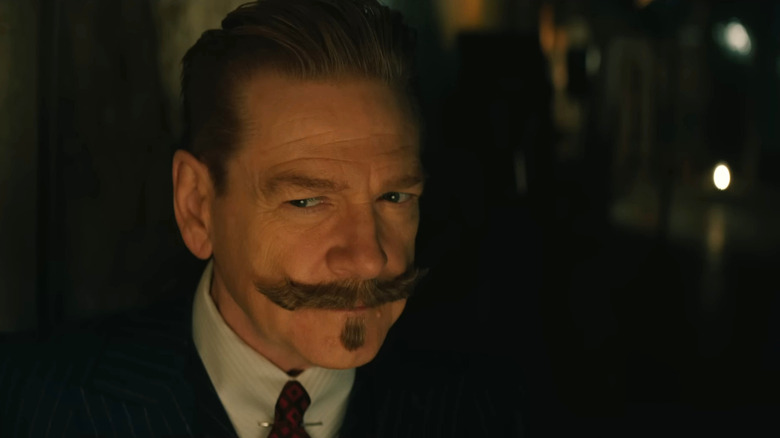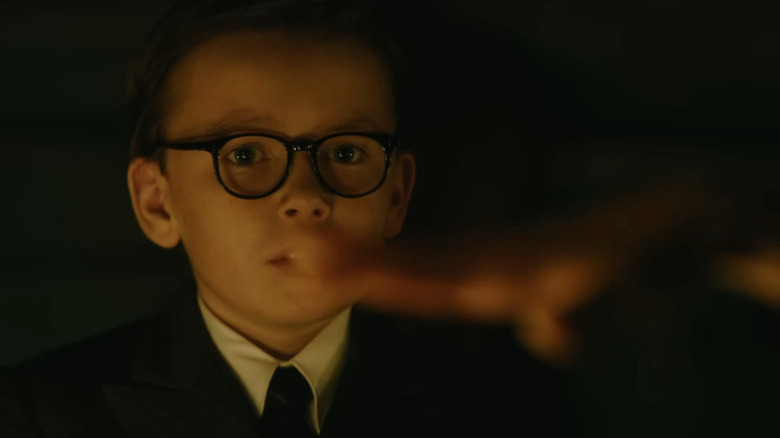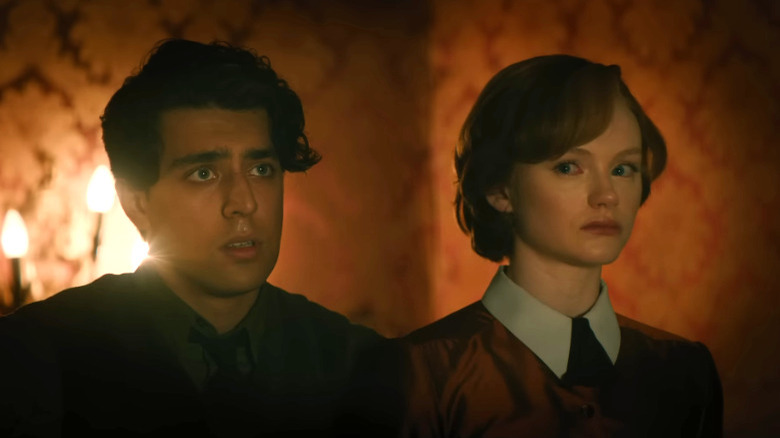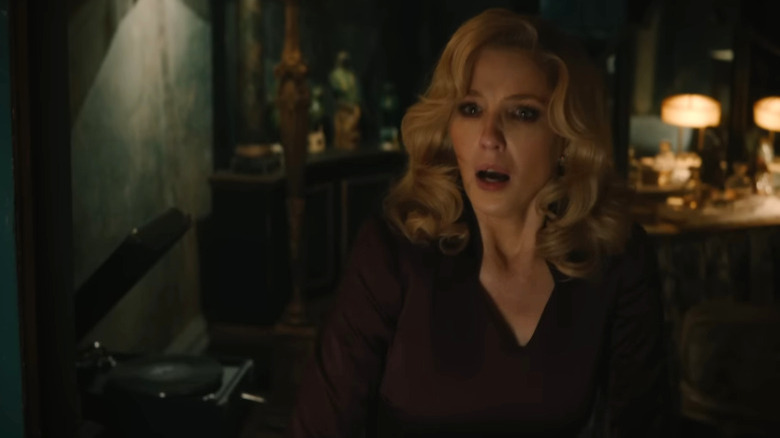You May Want To Keep A Close Eye On The Body Language In A Haunting In Venice
In the world of film criticism, critics are often dismissed by people who think that cinema should not be overanalyzed, or in some cases, analyzed at all. The expression goes that we should simply be able to "turn off our brains and enjoy the movie." It's a philosophy that argues that films are passive forms of entertainment: art that is intended to be merely ephemeral, with nothing to challenge our perspectives or preconceived notions, and no lasting impact on our psyche.
To put it another way, for those who wish to turn off their brains, movies are — to quote "The Simpsons" (albeit a little out of context) — "just a bunch of stuff that happened."
And while it may be tempting to try to disassociate and view motion pictures in as close to a vacuum as our minds can muster, filmmakers are usually trying to get us to snap out of that. Sure, some films may be soothing balms, but most are attempting to shake their audience out of complacency, and violently if necessary. Artists typically want their audience to feel something while experiencing their art, and to think at least a little bit about what the artist has done, or is doing.
Perhaps no motion picture genre embodies the active moviegoing experience as profoundly as the "whodunnit," a mystery whose solution is usually kept from the audience until the finale. If you "turned off your brain" while watching a whodunnit you couldn't enjoy the film on its intended level. You're supposed to scan every scene for clues, to see if you can outthink both the characters and the storytellers behind the camera. To fully appreciate a whodunnit, I argue that you need to turn your brain all the way on.
And in the case of Kenneth Branagh's "A Haunting in Venice," it seems that cinematographer Haris Zambarloukos agrees.
The scare in the big clue house
"A Haunting in Venice" is the third film starring Kenneth Branagh as Hercule Poirot, the whimsically vainglorious fictional detective created by Agatha Christie, who is literally the best-selling novelist in human history. The movie — which just like the remakes of "Murder on the Orient Express" and "Death on the Nile," Branagh also directed — very loosely adapts Christie's novel "Hallowe'en Party," and finds Poirot in the middle of a seance where, in the midst of his attempts to debunk a notorious spirit medium, someone also turns up dead.
Who is the murderer? "A Haunting in Venice," like so many great whodunnits, provides a wide assortment of potential suspects, each with their own motives, suspicious personality quirks, and secrets which — be they homicidal or comparatively benign — they wish to keep from one of the world's greatest detectives. Is the killer the opera singer whose daughter mysteriously died two years ago? Perhaps it's the doctor wrestling with PTSD, whose son also claims he can see ghosts. Maybe it's the dead daughter's gold-digging ex-fiancée, or one (or both) of the spirit medium's two con artist accomplices.
By the end, you can safely assume that Hercule Poirot will solve the mystery and probably uncover (and solve) a few more. Then again, half the fun is trying to figure it out for yourselves first, and Branagh, screenwriter Michael Green, and cinematographer Haris Zambarloukos are playing fair. So they've given you all the clues you need to find the answers first.
But don't just pay attention to the alibis and murder weapons. To get ahead of Hercule Poirot, according to Zambarloukos, what you should be watching are the performances.
Mystery: Possible
Zambarloukos worked as Branagh's director of photography on nine films so far, including the blockbusters "Thor" and "Cinderella," and the Oscar-winning drama "Belfast." And according to an interview with ScreenRant, they've changed their approach to filming "A Haunting in Venice." Not only is this film full of eerily lit rooms and bizarre, discomforting camera angles, but it's also designed to highlight everything the audience needs to play along.
"One of the things is in this film, I think we've slowed the pace down. So that's important. There's things that happen, little clues throughout. I think you have to pay attention and just look at the body language. There are clues in a way. I think we use the camera so sparingly that an adjustment a millimeter up or a millimeter down or a little bit wider, [you] will see things in the frame that I think help. You can gauge everything, but I would not say [on] a clue level."
If that sounds a little counterintuitive, that you can find clues just not on "a clue level," you may need a crash course in the whodunnit genre. While one purpose of the whodunnit is to engage the audience in the act of solving a puzzle, the puzzle itself is just one piece of ... well, the puzzle. Simply telling the audience who is responsible for the deaths in "A Haunting in Venice" may satisfy our intellectual curiosity, but it wouldn't be dramatically satisfying.
That's why some people prefer the term "whydunnit," since a murder mystery's themes and emotional resonance and, often, their very solution are directly tied to the motive for the killing. What human frailty has led somebody to commit murder, and what does that say about them? Or about us?
This means that you can't just accumulate the facts in a whodunnit. You have to pay attention to the acting too.
Body language of evidence
Haris Zambarloukos claims that, instead of searching for his frames' conventional clues, the trick to solving the mystery in "A Haunting in Venice" is in the performances he photographed. As he said:
"But I think you should view this in terms of understanding and maybe trying to be, if you wanted to try and be slightly ahead of the game, on an emotional level. I think that's the interpretation we were hoping for. That's the thing that maybe sets this apart from other films in this genre maybe. [And] I think that's really the kind of genius that Ken brought to this. His mise en scène there in the body language is incredible."
Zambarloukos is correct, of course. Kenneth Branagh has proven himself to be a superlative director of ensemble casts, in classic William Shakespeare adaptations like "Henry V," "Much Ado About Nothing," and "Hamlet." And in his three Agatha Christie movies, especially "A Haunting in Venice," the performances he wrings out of his cast of actors — including Michelle Yeoh, Tina Fey, and Branagh's "Belfast" stars Jamie Dornan, Kelly Reilly, and Jude Hill — are complex and often reflect or betray each character's inner turmoil. The inconsistencies aren't just with their alibis, they're within their own natures.
So if you want to get the most out of "A Haunting in Venice," or any other film like it, you can't just "turn off your brain and enjoy the movie." Turn that brain of yours back on and go hunting, because every image, every seemingly minor line of dialogue, and every tiny twitch or glance might be exactly the clue you need to beat Hercule Poirot, Agatha Christie, and Kenneth Branagh at their own game.



